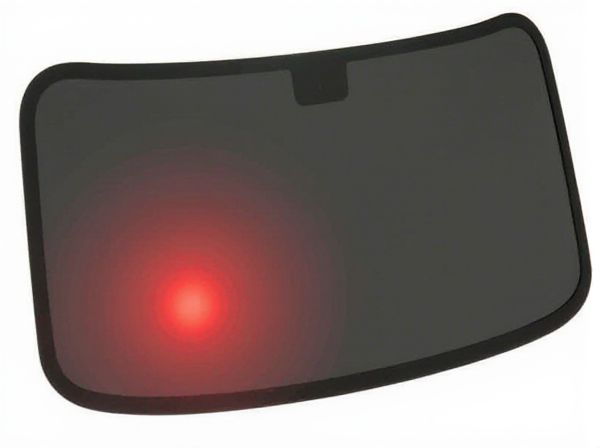
Photo illustration: Infrared Reflective Windshield vs Traditional Windshield
An infrared reflective windshield reduces heat buildup inside your vehicle by blocking infrared rays, enhancing comfort and decreasing the need for air conditioning. Traditional windshields lack this specialized coating, allowing more heat to penetrate the cabin. Choosing an infrared reflective windshield improves energy efficiency and protects interior materials from sun damage.
Table of Comparison
| Feature | Infrared Reflective Windshield | Traditional Windshield |
|---|---|---|
| Heat Reduction | Blocks up to 80% infrared heat, keeping interiors cooler | Minimal infrared heat blocking, interiors heat up quickly |
| UV Protection | Blocks up to 99% harmful UV rays | Standard UV protection, less effective |
| Glare Reduction | Significantly reduces glare for better visibility | Glare reduction is limited |
| Energy Efficiency | Improves vehicle energy efficiency by reducing AC load | No impact on energy efficiency |
| Durability | Enhanced durability with special coatings | Standard durability |
| Cost | Higher initial cost due to advanced technology | Lower upfront cost |
Understanding Windshield Technologies
Infrared reflective windshields incorporate multiple layers of specialized films that block and reflect infrared radiation, significantly reducing heat buildup inside the vehicle compared to traditional windshields, which primarily focus on visible light transmission. This advanced technology enhances passenger comfort and decreases the reliance on air conditioning, improving overall fuel efficiency and reducing environmental impact. Traditional windshields typically utilize laminated glass with UV protection but lack the capability to effectively manage infrared heat, making infrared reflective types a superior choice for modern automotive climate control.
What is an Infrared Reflective Windshield?
An Infrared Reflective Windshield is designed with a special coating that blocks a significant amount of infrared radiation from the sun, enhancing cabin comfort by reducing heat buildup inside the vehicle. Unlike traditional windshields, which primarily filter UV rays but allow infrared heat to pass through, infrared reflective windshields improve energy efficiency by lowering the need for air conditioning. This technology not only protects passengers from excessive heat but also helps in maintaining clearer visibility by minimizing glare and heat distortion.
How Traditional Windshields Work
Traditional windshields are made of laminated glass, which consists of two layers of glass with a plastic interlayer that provides structural integrity and safety by holding the glass together upon impact. They primarily block UV radiation but allow most infrared heat to pass through, resulting in higher cabin temperatures. This lack of infrared reflection causes increased reliance on air conditioning and can reduce overall driving comfort and fuel efficiency.
Key Differences Between Infrared Reflective and Traditional Windshields
Infrared reflective windshields incorporate a special coating that blocks up to 70% of infrared radiation, reducing heat buildup inside vehicles and improving energy efficiency by lessening the load on air conditioning systems. Traditional windshields lack this technology, allowing more infrared rays to penetrate, which results in higher interior temperatures and increased reliance on cooling. Additionally, infrared reflective glass enhances UV protection and reduces glare, contributing to greater occupant comfort and skin safety compared to standard windshield materials.
Heat Rejection Capabilities Compared
Infrared reflective windshields incorporate advanced coatings that significantly enhance heat rejection by reflecting infrared radiation, reducing cabin temperature and improving energy efficiency compared to traditional windshields. Traditional windshields primarily block visible light and UV rays but allow more infrared heat to penetrate, leading to increased reliance on air conditioning. Studies show that infrared reflective glass can reduce heat buildup by up to 50%, optimizing passenger comfort and lowering fuel consumption in vehicles.
Impact on Cabin Comfort and Temperature
Infrared reflective windshields significantly enhance cabin comfort by blocking up to 60% of infrared radiation, which reduces heat buildup inside the vehicle and lowers reliance on air conditioning compared to traditional windshields. Traditional windshields allow more solar heat to penetrate, resulting in higher cabin temperatures and increased energy consumption for cooling. This temperature regulation improves passenger comfort and contributes to better fuel efficiency in vehicles equipped with infrared reflective glass.
Effects on UV and Infrared Protection
Infrared reflective windshields significantly reduce infrared radiation transmission, lowering interior heat buildup and enhancing thermal comfort compared to traditional windshields. They block up to 70% of UV rays, providing superior protection against skin damage and interior material fading, whereas traditional windshields typically block only around 25-40% of UV radiation. Enhanced infrared and UV protection in infrared reflective windshields contributes to improved energy efficiency by reducing air conditioning load.
Durability and Longevity Comparison
Infrared reflective windshields feature advanced coatings that significantly enhance durability by reducing heat absorption, minimizing stress on glass fibers, and preventing premature deterioration. Traditional windshields, lacking these thermal control properties, are more prone to heat-related wear, leading to quicker degradation and potential cracking over time. This technological difference results in infrared reflective windshields generally offering superior longevity and maintaining structural integrity longer than traditional glass options.
Cost Implications and Installation
Infrared reflective windshields generally have higher upfront costs due to advanced coatings that block IR radiation, improving cabin comfort and reducing air conditioning use. Installation expenses may also be elevated because specialized handling and calibration are often required to maintain optical clarity and functionality of integrated sensors. Traditional windshields typically cost less initially and are simpler to install, but may lead to increased energy costs over time due to inferior heat rejection properties.
Choosing the Right Windshield for Your Vehicle
Infrared reflective windshields use advanced coating technology to reduce heat absorption by reflecting infrared rays, improving cabin comfort and reducing air conditioning load compared to traditional windshields. Traditional windshields primarily provide basic UV protection and impact resistance but allow more heat to enter the vehicle, leading to higher interior temperatures. Choosing the right windshield depends on factors like climate, energy efficiency preferences, and budget, with infrared reflective options offering significant benefits in hot climates and for reducing fuel consumption.
 caratoz.com
caratoz.com